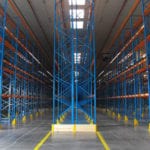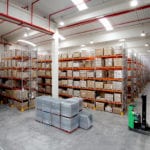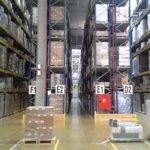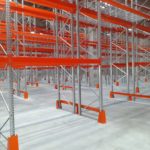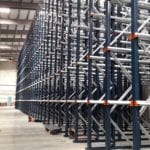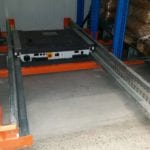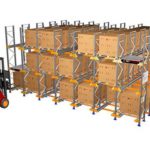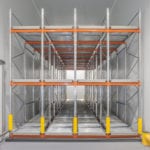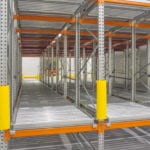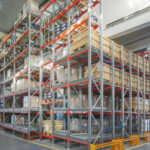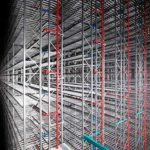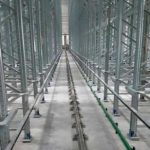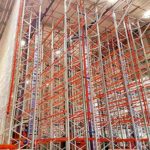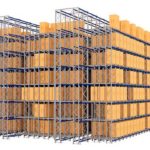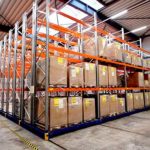Conventional pallet racking
The Conventional Pallet Racking storage system is the most common way to store palletised goods. This solution is recommended for storing mixed goods, access to pallets being made through suitably sized corridors according to the handling equipment. If circumstances so require, this storage system can also be configured with double-deep depth.
System properties
- Direct access to each pallet and fast tracking of the pallets, which allows optimization of stock records;
- Adapting the vertical configuration of the storage levels according to the size of the stored goods;
- Shelves can be configured to store heavy loads up to 28 tons per column;
- To increase the storage capacity, shelves can be installed as double-deep system if the type of product stored allows (the product is the same) or on movable rails, in which case direct access to each pallet remains an option;
- They are economical and sustainable;
- Easy to install and dismantle, allows system relocation or adjustment as needed;
- Suitable for all types of euro pallets, industrial pallets, net boxes or containers;
- Standard pallet stackers are used.
Drive-in pallet racking
The Drive-In rack system is designed to maximize storage space, resulting in a high density of pallets per cubic meter. The pallets are stored in a 2-block system, generally requiring only one operating lane. Thus, the surface available can be used much more efficiently, as opposed to accessing pallet rack shelving solutions. Drive-in rack storage is the perfect choice for warehouses with of cargo of the same kind.
Types of Drive-In Storage systems:
- The simple Drive-In is the most common. Pallet storage is made using the same access channel, therefore the LIFO principle is used.
- Double Drive-In is a storage system consisting of two Drive-in systems positioned back to back, the pallet picking principle being the same, LIFO.
- In the Drive-Through storage system, the pallets are stored using the front part of the system and they are retracted from the rear, thus facilitating a FIFO flow.
System properties
- The system ensures safe storage of palletised goods that are too fragile or unstable to be stored one above the other;
- Due to the high density type of storage, this system greatly increases efficiency in a hall;
- It allows storage of most pallets per cubic meter than any other storage system;
- Eliminates the need for multiple lanes for cargo handling;
- The Drive-In system is used for storing / picking up pallets according to the LIFO principle (last-in-first-out) but also FIFO (first-in-first out) for the Drive Through type of storage;
- It is well suited for slightly diversified merchandise warehouses;
- Successfully used in controlled temperature applications;
- Forklift guiding rails are positioned inside the shelf, thus eliminating the risk of collision and damage to the system.
Radio Shuttle
The Radio Shuttle system is a semi-automatic storage system based on the Drive-In principle, bringing a big plus in reducing the time spent to load and unload the pallets.
This is done with the help of an automatic trolley that can move independently on its rails inside the shelf, thus no longer needing a forklift to work inside the storage channels. The operator performs all the pallet storage and extraction procedures with a simple remote control.
System properties
- Operational flexibility: efficient loading and unloading system with high precision through automation of processes;
- The handling time of the goods is considerably reduced by approximately 50%;
- Operation based on two principles - FIFO and LIFO;
- Space optimization - Minimizing the number of service lanes between shelves;
- Ability to adapt to existing drive-in systems;
- Full utilization of tunnel depth;
- Risk-free operation due to the highest precision in handling the goods. This avoids damage to the racking system and damage to the goods - avoiding pallets clashing one into the another;
- The radio shuttle trolley is adaptable to tunnels of various sizes;
- Ideal for storage at low temperatures;
- It can be used in combination with regular motor- or electric forklifts used for handling goods outside the storage channels.
Pallet live storage
This system operates based on the force of gravity, being driven by the own weight of the pallet, which moves on a roller guide conceived in an inclined plane. It is especially useful to store the same type of cargo, in the form of pallets, in the FIFO system (first in – first out). The pallets are stored on one side of the channel and slide due to the force of gravity on rolling inclined lanes to the picking area. This type of storage is often used in the food industry or for the storage of intermediate components in production units, requiring only two operating lanes – for storage and picking.
System properties
- Up to 60% less horizontal space is used than when accessing pallet rack solutions;
- The operating speed within the hall is increased - thanks to the FIFO system, an automatic inventory rotation is ensured;
- The gravity system is especially designed to store products that need a quick flow of rotation;
- Access to goods is quick;
- There is a dedicated loading side and a picking side - 2 lanes;
- The storage lane has a slope of about 4%, due to which the pallet placed on the Drop location continues gravitationally its movement along the tunnel to the last free location;
- The system is provided with several types of accessories to ensure safety of system operation. For instance, brake at the end of the rollers, stopper, pallet guidance system, etc.
High Bay racking
The High-Bay storage system is part of the project category that requires special analysis and sizing conditions. Particular attention is needed both at the time of manufacture as well as during assembling, as it is very important that positioning and flatness are perfect. For storing and picking up pallets, this storage system requires the use of cranes. They run on rails mounted on the floor and are guided at the mast for greater stability when handling.
System properties
- Special merchandise handling equipment is required. This equipment is called Stacker Crane and has both horizontal movement, along the access corridor as well as vertical movement, moving up to the height of the location where a pallet has to be placed / picked up from;
- The use of the High Bay system allows for increased storage capacity, a considerable contribution being made by optimizing the Stacker Crane movements;
- The activity is coordinated entirely automatically through the warehouse management CSB computer. The software application manages the storage locations, coordinates the warehouse entry and exit processes, as well as the rack access equipment and conveying technique;
- The loading / unloading operations are automatically recorded;
- Human errors are eliminated;
- Controlling and updating inventory;
- The High Bay system is operative throughout the year, day and night;
Mobile Pallet Racking
The Mobile Shelving System is made up of a Pallet-Rack system mounted on a mobile base which allows opening and closing of the working lanes. This rack system is ideal for warehouses where we have a limited and expensive space, such as cold storage, but where easy access to each pallet is still required. The mobile rack system offers the possibility of minimizing the work corridors, thus the storage space is used at maximum capacity.
System properties
- Mobile shelving systems move on rails fixed to the floor and can be loaded with cargo up to 24 tons;
- It is suitable for any type of goods;
- Also recommended for cold storage;
- The coverage area is approximately 80%, compared to a conventional shelving system, which has a coverage area of about 40%;
- Maximum use of horizontal space - one operational aisle;
- 100% access to individual pallets;
- Mobile systems can be manually operated or automated with a remote control.









